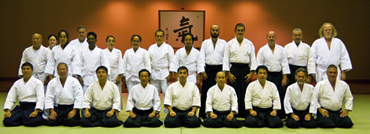
I
have had more opportunities recently to teach both professional baseball players
and coaches.
Through
teaching these players and coaches, it has also helped my own understanding deepen.
An
example of this deepening of my own understanding is what I call “The Holding
of Things.”
To
hold or carry something, is actually one of the most basic movements or actions
that human beings do all the time, while at the same time being probably one of
the most complex or ‘‘high level’’ actions or movements that we all take for
granted.
When
a player in good form or condition holds a bat, his hold is supported by his
whole body as one. Even by applying Ki Testing by pushing the bat, the player
does not get affected.
A
player, who is not in good form or condition, usually holds the bat only with
his hands. By applying Ki test and pushing the bat, not only does his bat move,
but his whole posture also waivers.
Human
beings are fortunate in the way that our wrists function and move. Technically
just by moving our wrists we can swing a bat, which as the Japanese phrase “Kote
Saki” implies, literally means moving only with wrists.
Ki
Testing is first applied to check if the posture of the player is stable and
calm, then it is applied again to check the player’s posture when he holds a
bat. The stability of a player’s posture should always be calm and stable
regardless of whether he is holding or not holding a bat, this is an important
part of training which is practiced continuously.
By
repeating this practice continuously, the player can understand the difference
through feeling.
The
same thing also applies when practicing Shinshin Toitsu Aikido.
When
we practice Aikido techniques, we use our hands to perform the throw or
techniques. If our throw feels incomplete or it doesn’t feel correct, it
usually means that we are only just using our hands to throw. In Japanese this
is called “Kote Saki”.
This
is why it is very important to always practice checking of the stability of our
posture, to make sure that it is always calm and stable with our mind and body
being unified as one. This feeling should be applied when we perform Aikido
Techniques. We should not be practicing ‘throwing just with our hands’ but we
should always practice ‘throwing and moving with our whole body as one.’
Let
us return back to the topic of: The Holding of Something.
When
we hold something tightly (like grabbing or squeezing) this puts unnecessary
tension and strain into our whole body resulting in our reaction and
performance being less efficient than we actually think.
On
the contrary, to just hold something lightly and loosely means we will not be
able to apply and exert the correct amount of force when using or holding
something. We should always hold with Ki extending and flowing, therefore, ‘Holding
with Ki’ is a very important.
In
Shinshin Toitsu Aikido training, we often practice with the holding of bokken.
One of the purposes of this practice is for our bodies to be able to feel and
get used to ‘holding with Ki’.
When
we try hard to hold things, our Ki has already stopped flowing. In this case,
by applying Ki Testing to check our posture, we can see that our posture is
less stable and disturbed easily.
By
continuously practicing holding the Bokken lightly with Ki flowing to the tip,
we can catch the feeling naturally and our posture starts to become stable and
calm even when holding a bokken.
Once
we get the correct feeling with continuous training and practice, we can apply
it to the holding of a bat, or the holding of a golf club, or even holding a
brush when practicing Calligraphy.
Improvement
in performance can be seen for baseball players, when they hit with their bat
they will have more strikes, for golfers, they will have better scores during
their games, and a calligrapher will be able to write characters with more Ki
flow present in their work.
‘Holding
with Ki’ means that Ki should always be flowing continuously throughout, with
whatever we hold.


